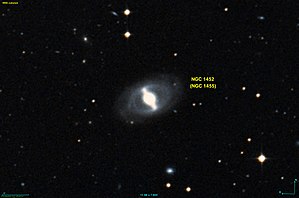NGC 1452
| Galaxy NGC 1452 / NGC 1455 |
|
|---|---|

|
|
| AladinLite | |
| Constellation | Eridanus |
|
Position equinox : J2000.0 , epoch : J2000.0 |
|
| Right ascension | 03 h 45 m 22.3 s |
| declination | -18 ° 38 ′ 01 ″ |
| Appearance | |
| Morphological type | SB (r) a |
| Brightness (visual) | 11.9 likes |
| Brightness (B-band) | 12.8 mag |
| Angular expansion | 2.8 ′ × 1.5 ′ |
| Position angle | 113 ° |
| Surface brightness | 13.3 mag / arcmin² |
| Physical data | |
| Affiliation | Eridanus group SSRS group 72 NGC 1400 group NGC 1407 group LGG 100 |
| Redshift | 0.005794 ± 0.000033 |
| Radial velocity | 1737 ± 10 km / s |
|
Stroke distance v rad / H 0 |
(74 ± 5) · 10 6 ly (22.6 ± 1.6) Mpc |
| history | |
| discovery | William Herschel |
| Discovery date | October 6, 1785 |
| Catalog names | |
| NGC 1452 • 1455 • PGC 13765 • ESO 549-012 • MCG -03-10-044 • 2MASX J03452230-1838010 • SGC 034307-1847.4 • GC 777 • H II 459 • LDCE 251 NED051 | |
NGC 1452 = NGC 1455 is a bar-spiral galaxy of the Hubble type SBa in the constellation Eridanus in the southern sky . It is estimated to be 74 million light years from the Milky Way and about 60,000 light years in diameter. The galaxy is considered a member of the Eridanus Galaxy Cluster and the NGC 1407 group, or LGG 100 .
In the same area of the sky are u. a. the galaxies NGC 1430 and NGC 1440 .
The object was discovered by Wilhelm Herschel on October 6, 1785 .
